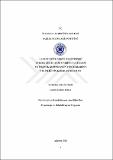DSpace Repository
LATENT TETİK NOKTA TEDAVİSİNDE YÜKSEK GÜÇTE AĞRI SINIRINDA ULTRASON VE İSKEMİK KOMPRESYON YÖNTEMLERİNİN ETKİNLİĞİNİN KARŞILAŞTIRILMASI
JavaScript is disabled for your browser. Some features of this site may not work without it.
| dc.contributor.author | Pala, Gamze Gülsün
|
|
| dc.date.accessioned | 2019-06-01T14:13:34Z | |
| dc.date.available | 2019-06-01T14:13:34Z | |
| dc.date.issued | 2018 | |
| dc.identifier.uri | http://hdl.handle.net/11547/2413 | |
| dc.description.abstract | Çalışmamızın amacı Latent Tetik Nokta (LTN) tedavisinde Yüksek Güçte Ağrı Sınırında Ultrason (YGAS-US) ve İskemik Kompresyon tekniklerinin ağrı, basınç ağrı eşiği (PPT), duygu-durum, yaşam kalitesi ve disabilite üzerine etkilerini belirlemektir. Üst trapez, Levator Skapula, Supraspinatus, İnfraspinatus, Deltoid Anterior, Pectoralis Majör, Pectoralis Minör kaslarında minimum 3 LTN bulunan 173 olgu çalışmaya dahil edildi. Ağrı, duygu-durum, yaşam kalitesi ve disabilite değerlendirmeleri tedavi öncesi, tedaviden 1 hafta ve 4 hafta sonrası yapıldı; PPT değerlendirmeleri tedavi öncesi, tedaviden hemen sonrası ile tedaviden 1 hafta ve 4 hafta sonrası yapıldı. Grup 1’e YGAS-US tekniği, dozun kişinin tolere edebildiği en üst seviyeye arttırıldığı ve US başlığının sabit tutulduğu evreden sonrasında dozun sabit tutulduğu şekilde uygulandı. Grup 2’ye YGAS-US tekniği, dozun kişinin tolere edebildiği en üst seviyeye arttırıldığı ve US başlığının sabit tutulduğu evreden sonrasında dozun yarıya düşürüldüğü şekilde uygulandı. Grup 3’e ise İskemik Kompresyon tekniği uygulandı. Ağrı Görsel Analog Skala (GAS) ile, PPT algometre ile, duygu-durum Beck Depresyon Ölçeği (BDÖ) ve Durumluk – Sürekli Kaygı Envanteri (STAI TX-1, STAI TX-2) ile, yaşam kalitesi SF-36 Sağlık Denetimi Formu ile, disabilite Boyun Ağrısı ve Disabilite Skoru (BADS) ile değerlendirildi. Grup içi değerlendirmede, Grup 1 ve Grup 2’de ağrı, PPT ve duygu-durum parametrelerinde iyileşme bulundu (p<0,05). Grup 3’te ise ağrı, PPT, duygu-durum ve disabilite parametrelerinde iyileşme bulundu (p<0,05). Gruplar arası fark “ANOVA” ile değerlendirildiğinde, ağrı parametresinde ve PPT’nin bazı alt parametrelerinde Grup 3 Grup 2’ye göre istatistiksel olarak anlamlı farklı bulundu (p<0,05). Duygu-durumun bazı altparametrelerinde, disabilite parametresinde ve PPT’nin bazı altparametrelerinde Grup 3 Grup 1’e göre istatistiksel olarak anlamlı farklı bulundu (p<0,05). Bu çalışmanın sonucunda, LTN tedavisinde hem YGAS-US tekniğinin iki farklı şekilde uygulanışı hem de İskemik Kompresyon tekniği etkili bulundu. İskemik kompresyon tekniği ağrı, depresyon, disabilite ve PPT üzerine YGAS-US uygulamasından daha etkin bulundu. YGAS-US tekniğinin doz sabit tutularak uygulanma şekli, ağrı üzerine YGAS-US tekniğinin doz yarıya düşürülerek uygulanma şekline göre daha etkili bulunurken; YGAS-US tekniğinin doz yarıya düşürülerek uygulanma şekli de depresyon üzerine YGAS-US tekniğinin doz sabit tutularak uygulanma şekline göre daha etkili bulundu. | tr_TR |
| dc.language.iso | tr | tr_TR |
| dc.publisher | İSTANBUL AYDIN ÜNİVERSİTESİ SAĞLIK BİLİMLERİ ENSTİTÜSÜ | tr_TR |
| dc.subject | Tetik nokta | tr_TR |
| dc.subject | Yüksek güçte ağrı sınırında ultrason | tr_TR |
| dc.subject | İskemik kompresyon | tr_TR |
| dc.subject | Trigger point | tr_TR |
| dc.subject | High power pain threshold ultrasound | tr_TR |
| dc.subject | İschemic compression | tr_TR |
| dc.title | LATENT TETİK NOKTA TEDAVİSİNDE YÜKSEK GÜÇTE AĞRI SINIRINDA ULTRASON VE İSKEMİK KOMPRESYON YÖNTEMLERİNİN ETKİNLİĞİNİN KARŞILAŞTIRILMASI | tr_TR |
| dc.type | Thesis | tr_TR |
| dc.description.abstractol | The aim of our study; was to determine the effects of High Power Pain Threshold Ultrasound Therapy (HPPT-US) and Ischemic Compression used in Latent Trigger Points (LTrPs) treatment on pain, pressure pain threshold (PPT), emotional state, quality of life and disability. 173 cases who have at least 3 LTrPs in upper trapezius, levator scapulae, supraspinatus, infraspinatus, deltoid major, pectoralis major and pectoralis minimus muscles were included in the study. Pain, emotional state, quality of life and disability were assessed before treatment, 1 week and 4 weeks after treatment; PPT evaluations were performed before treatment, immediately after treatment and 1 week and 4 weeks after treatment. The HPPT-US technique was applied to Group 1 in such a way that the dose was increased to the highest level that the case could tolerate and the dose was kept constant after the US head was kept constant. The HPPT-US technique was applied to Group 2 in such a way that the dose was increased to the highest level that the case could tolerate and the dose was reduced after the US head was kept constant. Group 3 received ischemic compression technique. Measurements used were the visual analog scale (VAS) for pain, PPT algometry results, Beck Depression Scale and The State-Trait Anxiety Inventory (STAI TX-1, STAI TX-2) for emotional state, Short Form Health Survey 36 (SF-36) for quality of life, Neck Pain and Disability Index (NPDI) for disability. Significant improvement was found after treatment on pain, PPT and emotional state parameters in Group 1 and Group 2 (p <0.05). In Group 3, significant improvement was found after treatment on pain, PPT, emotional state and disability parameters (p <0.05). When the groups compared by ANOVA it was found that pain and some subparameters of PPT were statistically different in Group 3 compared to Group 2 (p<0,05). Some subparameters of emotional state, disability parameter and some subparameters of PPT were statistically different in Group 3 compared to Group 1 (p<0,05). As a result of this study, both the application of HPPT-US technique and the Ischemic Compression technique were effective in LTrPs treatment. The Ischemic Compression technique was more effective than HPPT-US technique on pain, depression, disability and PPT. The application of HPPT-US technique by keeping the dose constant is more effective than the application of HPPT-US technique by reducing the dose rate on the pain; the application of HPPT-US technique by reducing the dose is more effective than the application of HPPT-US technique by keeping the dose constant on depression level. | tr_TR |
| dc.publisher.firstpagenumber | 1 | tr_TR |
| dc.publisher.lastpagenumber | 120 | tr_TR |
Files in this item
This item appears in the following Collection(s)
-
Tezler -Thesis [17]
